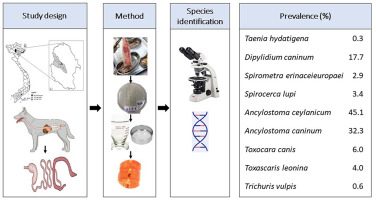
Helminthiases in dogs and cats
Every owner knows that a pet needs to be treated for helminths (worms) – parasitic worms that infect the animal’s body. Let’s talk in more detail about the types of endoparasites, ways of infection and other points related to this problem – how to detect helminths in a pet and what measures to take?
Contents
Types of parasites
All helminths are divided into three large groups: nematodes (roundworms), cestodes (flat tapeworms), trematodes (flat fluke worms). There are a huge number of species. Let’s talk about the most common ones.
Opisthorchiasis
A disease caused by the trematode Opisthorchis felineus (cat fluke). Adult parasites live in the liver and bile ducts of the host. In severe infections, the number of parasites can reach 40 thousand individuals. This parasite has an elongated body, 8-13 mm long and 1,2-2 mm wide. Opisthorchis develops with a change of three groups of hosts: humans and domestic animals (dogs, cats, pigs) are the final host. The eggs of parasites excreted with faeces from the soil by water enter the reservoirs. Intermediate hosts are freshwater mollusks – bitinia. The eggs are swallowed by the molluscs, and the larvae develop in their bodies. Thousands of larvae come out of the mollusks, which float freely in the water, but they are not dangerous for humans, therefore, it is impossible to get infected with opisthorchiasis through water. An additional host is carp fish: ide, roach, bream, carp, tench, bleak, minnow. Animals and humans become infected by eating fish infested with opisthorchis. In the liver of definitive hosts, the parasite becomes sexually mature after 3-4 weeks, and the entire development cycle of opisthorch lasts 4-4,5 months. Opisthorchis have a mechanical effect on the mucous membranes of the bile ducts of the liver, which leads to their inflammation, expansion, and difficulty in the outflow of bile. With a high intensity of invasion, cirrhosis of the liver develops.
Diphyllobothriasis
The causative agent is tapeworm diphyllobothriasis latum (wide tapeworm). The length of the parasite can be from 2 to 15 meters! We have possible infection with two types of tapeworms – diphyllobotriums: a wide tapeworm and a small tapeworm. The larvae of these parasites are found in muscles and caviar, on the shell of milk and some internal organs of freshwater fish – roach, bream, carp, pike, burbot, pike perch, perch, as well as salmon and whitefish – pink salmon, chum salmon, sockeye salmon, trout, trout . In the small intestine, the larvae attach to the walls and gradually grow into a mature worm. The process of development of the parasite lasts about three weeks. In cats, diphyllobotriums can live for about two months, then they die. The life expectancy of small tapeworm dogs is small – about six months, and a wide tapeworm can live up to two years. Diphyllobotriums have adapted well to living in various hosts. In addition to humans, dogs and cats, they also infect many wild animals. The size of the worm depends on the size of the host. In small animals, worms do not reach their maximum size, while in large animals they grow to an average of five meters.
Egg development occurs in freshwater reservoirs. The ciliary larva (coracidium) emerges from the egg 6-16 days after entering a favorable environment. After ingestion by copepods, the coracidium turns into a procercoid after 2-3 weeks. In the body of fish that eat crustaceans, procercoids penetrate into the internal organs and muscles, and after 3-4 weeks they turn into plerocercoids, reaching a length of 4 cm. The plerocercoid turns into a sexually mature worm already in the body of the final host.
Tapeworms injure the intestinal wall with their attachment organs, which causes inflammation of the mucous membrane. The processes of normal digestion and absorption of food are disturbed. At the same time, the worms actively consume vitamins from the animal’s food, especially vitamins B12 and folic acid. Against the background of low gastric acidity, a deficiency of these vitamins causes severe iron deficiency anemia. Iron deficiency is accompanied by a violation of hematopoiesis caused by toxins secreted by parasites. The combination of these factors can lead to severe anemia that is difficult to treat. Folic acid deficiency during pregnancy can lead to spontaneous abortions or the birth of offspring with congenital pathologies of the nervous system.
Dipylidiosis
The causative agent is the tapeworm Dipylidium caninum (cucumber tapeworm). The causative agent of this disease is called the cucumber tapeworm, since its structural unit – the segment is clearly visible to the naked eye and looks like a cucumber seed, the length of an adult worm reaches 70 cm. Dogs and cats become infected by eating adult infected fleas or withers. Most often, owners notice the presence of helminths when the segment separates from the tapeworm and can be seen crawling on the cat’s feces or on the fur of the tail. Dipylidiums have an allergotoxic effect on the body of sick animals, their digestive function is disturbed, young animals become emaciated, become nervous. Dipilidiosis is widespread everywhere, especially in big cities, where stray dogs and stray cats are often found.
Echinococcosis
The causative agent is tapeworms of the genus Echinococcus. In the small intestine of dogs, echinococcus and alveococcosis develop into an adult in 2-3 months. In the mature stage, the pathogen parasitizes in the small intestine of dogs, foxes, which are the definitive (final) hosts. In the larval stage, this helminth develops in intermediate hosts – cattle, sheep, goats, pigs, horses, as well as in humans. Cestodes of both types in the intestines of dogs live for about 5-7 months. The larvae of these helminths are contagious to humans, the consequences of infection are very serious, up to death. In the intestines of an infected dog, the larvae emerge from the eggs. After that, they penetrate into the blood vessels and enter the organs, where they turn into echinococcal blisters. Most often, dogs are at risk when eating raw meat. Dogs excrete segments with feces, in which there are a lot of eggs. Mature segments are mobile, and are able to move up to 25 cm, releasing eggs into the external environment through ruptures in the walls. They, in turn, can persist, under favorable environmental conditions, for several months. Echinococci disrupt the function of the organ, lead to its atrophy. The contents of the bladder causes intoxication of the body.
Toksokaroz
The causative agent is nematodes of the genus Toxocara. Ascaris dogs Tohosaga canis is a ubiquitous parasite. In our natural conditions, this is the most common helminth in dogs. The cat roundworm Toxocara cati (T. Mystax) is a common parasite and in our conditions is the most common helminth in cats. Toxocara have a very complex life cycle, which ensures that they use all the mechanisms of penetration into the host organism. Infection of dogs and cats with toxocara occurs in several ways. The first way is direct infection, when they swallow their eggs with street dirt. Also – air-dust method of infection. Together with street dust, toxocar eggs are lifted into the air by the wind, finally, simply with the active movement of the dog. We bring Toxocar eggs on shoes from the street home, here they become part of house dust, get on the animal’s fur and then get inside when licked. In the intestine, the parasite larva emerges from the egg. The second way is with the use of additional hosts, in the body of which Toxocara larvae do not develop, but accumulate in the internal organs. For Toxocara, such hosts are rodents and even earthworms. When they are eaten, mostly homeless animals become infected, as well as domestic cats and dogs that catch mice. The further path of toxocara larvae that entered the body of a dog or cat in the first or second way is similar. The larvae actively penetrate the intestinal wall and penetrate into the blood vessels. With the blood flow, they reach the lungs, where part of the larvae breaks the alveoli and penetrates into the lumen of the bronchi and trachea. From there, either actively crawling, or when the animal coughs up, they fall into the mouth and are then swallowed along with saliva. In this way, Toxocara larvae again enter the intestine and here they finally develop into adult worms. Another part of the larvae does not leave the bloodstream in the lungs, gradually settling in various internal organs. These larvae turn not into intestinal, but into tissue parasites. They can affect any internal organs, most often the lungs, liver, lymph nodes, spleen and brain. Toxocara larvae do not grow in the internal organs. Pregnancy is a special stimulus for migration for toxocara larvae: when the hormonal background of the animal changes, the larvae together leave their “familiar places” and with the blood flow reach the placenta, which they actively overcome, then enter the bloodstream of the developing fetus and affect its tissues. Shortly after the birth of puppies or kittens, the larvae again enter their bloodstream and pass through the path already described above through the lungs to the intestines, where they quickly develop into sexually mature worms. But the possibilities of infection with toxocariasis do not end there! Part of the larvae remaining in the internal organs of the mother, after the birth of the young, again enters the bloodstream, passes into the mammary glands and enters the milk. If the mother becomes infected with toxocariasis during feeding, the larvae also end up in the milk. These larvae infect puppies or kittens by sucking. After 3 weeks, breeding worms appear in the intestines. Thus, Toxocara use all possible ways of infecting hosts. A person becomes infected with toxocariasis in all the same ways as animals. But in humans, intestinal forms develop extremely rarely, usually Toxocara larvae affect only internal organs. Ocular toxocariasis develops when the larvae penetrate the eyes, it leads to a decrease in vision, the development of inflammatory diseases of the eye, even blindness. Especially dangerous for pregnant and lactating women.
Dirofilariasis
The causative agent is a nematode of the genus Dirofilaria. The length of adults reaches 40 cm, diameter up to 1,3 mm. Dogs and cats are the definitive (primary) hosts that serve as a reservoir for infection, while humans are “dead-end” hosts, in whose body the life cycle of dirofilaria is interrupted. Intermediate hosts are mosquitoes of the genera Culex, Anopheles and Aedes. Cats, although they are susceptible hosts, are more resistant to infestation. During a mosquito bite, invasive stage larvae enter the body, develop in the subcutaneous tissue for several months, and then migrate into the systemic circulation and pulmonary arteries. Most of the helminths die when they reach the pulmonary arteries, this occurs 3-4 months after the onset of infection, at the stage of immature adults. In most cases, less than six adult helminths develop, usually one or two individuals. But, given the small weight of the cat, this is always a heavy invasion. In dogs, a distinction is made between cardiac dirofilariasis, which is caused by Dirofilaria immitis, which parasitizes the heart and large vessels, and subcutaneous dirofilariasis, caused by Dirofilaria repens, which is localized in the subcutaneous tissue. Occasionally, sexually mature forms of dirofilaria can be found in atypical places: in the spinal cord or brain, in the eyes, in the abdominal cavity. Migrating with the bloodstream throughout the body, the larvae can cause blockage of the lumen of blood vessels. Adult parasites cause mechanical damage to the inner lining of the heart, endocarditis and dysfunction of the heart valves, and also interfere with blood flow, which causes insufficient oxygen supply to tissues and organs. The waste products of helminths and especially their decay products upon death have a toxic effect on the host organism. In the case of cardiac dirofilariasis, heart failure, shortness of breath, edema, and cyanosis of the mucous membranes are characteristic. Against the background of intoxication, the kidneys and liver are affected, ascites may appear. With a strong infection, nervous phenomena and weakness of the hind limbs are noted. With subcutaneous dirofilariasis, itching, hair loss, ulcers and redness on the skin are possible.
Trichinosis
The causative agent is nematodes of the Trichinellidae family. An adult helminth has a length of 1,5 mm. Trichinella lives and parasitizes in dogs, cats, rats. Once in the body of an animal, Trichinella goes through a full cycle of development, while living in the body for about 50 days. In their sexually mature form, they live in the small intestine, where the larvae born by the female with blood and lymph flow are carried to all organs and tissues, while the bulk of the larvae settle in the skeletal muscles, where the larvae coil up in a spiral and reach the invasive stage in 17 days. After 21-28 days, a lemon-shaped capsule forms around the larvae, and then they remain viable for many months and years, for example, in humans – up to 25 years. Infection of dogs and cats with trichinosis occurs when they eat meat products infested with trichinosis, as well as when they eat (this especially applies to hunting dogs) waste from killed wild animals that were sick with trichinosis. People are also infected with trichinosis, so everything related to the methods of infection applies to them. Cats are susceptible to all four types of Trichinella. Dogs, on the other hand, are relatively resistant to infection with the capsuleless species. They affect only young dogs, and in their bodies the larvae of Trichinella of this species die within a few months without causing severe pathologies. Therefore, poultry meat is not dangerous for adult dogs. With trichinosis, the intestines, vascular system and skeletal muscles are simultaneously affected. In acute trichinosis, blood coagulability parameters change, thrombosis of arteries and veins often develops. A common complication of trichinosis is pneumonia. All this can lead to the death of the animal. If the body of the animal copes with the period of acute trichinosis, the stage of chronic trichinosis begins. During this period, Trichinella larvae, surrounded by capsules formed from the cells of the affected organism, continue to affect the host organism. Capsules germinate with blood vessels, through which the larvae receive the substances they need, and through them they secrete the products of their vital activity into the blood of the animal. In this state, they can remain until the end of the life of the animal. Long-term existence of Trichinella larvae in the body leads to the development of severe insufficiency of the immune system.
Symptoms of helminthiasis
Very often, helminthiases are chronic conditions and do not manifest themselves in any way, or the changes are so minor that the owners associate them with other problems or do not notice at all. Common symptoms include:
- dysfunction of the gastrointestinal tract, such as constipation or diarrhea;
- blood or mucus in the stool;
- detection of segments or adult helminths in vomit or feces.
- vomiting;
- pica;
- anorexia;
- cough
- anemia;
- ascites;
- deterioration in the quality of wool;
- lethargy and weakness
- edema
- allergic skin reactions
- unmotivated aggression and nervous disorders
Diagnostics
- Parasitological study of feces. It is the most widely used research method. However, it does not give a 100% correct result if parasites are not detected. Doctors recommend taking several stool samples collected every other day, for example, 1,3,5 days or stool collected in one day from several consecutive bowel movements. A sample the size of a walnut is sufficient for analysis. Feces do not have to be fresh, but it is recommended to store them in a cool place.
- An ultrasound examination using the latest generation devices can detect helminths both in the intestines and in the heart, usually this is an accidental finding.
- A blood test if dirofilariasis is suspected, microfilariae may be detected in the sample.
Treatment
For treatment, anthelmintics are used in the form of tablets, suspensions, sugar cubes or in the form of drops at the withers. Therapeutic treatment is carried out according to the instructions for the drug. As a rule, anthelmintics are used twice, and sometimes thrice with an interval of 10-14 days. Sometimes it is necessary to resort to surgical methods of treatment, for example, with dirofilariasis of both forms. The rest of the therapy is non-specific, aimed at eliminating symptoms: replenishment of nutrients, diets and supplements that improve the general condition.
Prevention
In order to prevent helminthiasis, it is recommended to feed cats and dogs with quality food, drink water from trusted sources, do not let the dog pick up anything on the street from the ground and catch and eat mice. Keep clean the bowls, toys and beds of the pet, and in order to avoid infection of the owner, observe sanitary and hygienic standards when communicating with the animal. Timely treat the pet from ectoparasites, including mosquitoes, and endoparasites – carry out preventive treatment with broad-spectrum drugs once every 1 months. Since you should not forget that you can bring helminth eggs into the house on your shoes or clothes, so animals that never go outside also have a risk of infection.





